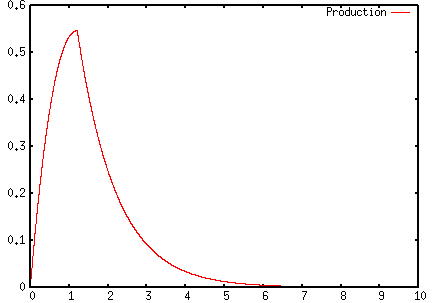Assume  and
and  are the amount of oil in the ground and the production rate respectively. We model the behaviour of the oil field with a system of linear ordinary differential equations (ODEs).
are the amount of oil in the ground and the production rate respectively. We model the behaviour of the oil field with a system of linear ordinary differential equations (ODEs).


In clear text, this means that the amount of oil in the ground decreases by the amount produced, and the production capacity increases if it is small compared to the amount of oil left in the field, and decreases if it is large compared to this amount.
Now, the system is easily transformed into a single ODE by differentiating the second equation and inserting for  from the first equation. This gives
from the first equation. This gives

which is has a simple analytical solution. The general solution is

Now we impose the initial conditions

which translates to some finite amount of oil in the reservoir, and the production capacity 0 at the time we start. These two conditions are used to determine the coefficients  and
and  . The solution is then
. The solution is then

This solution reveals that the model has some obvious flaws. The first thing that becomes apparent when plotting the solution (or simply noticing the sine factor), is that the production becomes negative at times. Another flaw, is that if we integrate the production from the start to the time it becomes negative, the amount of oil extracted is larger than the amount that was originally in the field. Clearly, some modifications to the model are needed. A fix is to replace the first equation by

This new equation makes the system a lot harder to solve by hand. Using a computer program and Euler’s method for explicit time-integration, it was easy to plot the result, however.

This time, the integral is 1 (at least with numeric integration), and the production is never negative.
Compared to real-life oil fields, the model production is ramped up too fast. The model does not incorporate the effects of limited manpower, investment and equipment. A sharp cliff is present where the technical production capacity exceeds the geological capacity of the field. This cliff should not be observed in any well-planned oil project, since no-one would invest in bringing production capacity beyond what the field can handle.

Interesting, although I didn’t have time to read through the whole thing. You certainly have a looot more time on your hands now 😉 I’ll read it later, maybe when I have more time on my hands.